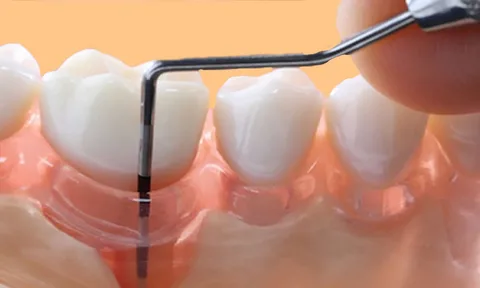Dental professionals rely on a periodontal pocket marker as one of the most important tools for maintaining good . Oral hygiene and preventing periodontal disease. Improving periodontal care diagnosis and treatment results requires an understanding of its importance, application, and advantages. We’ll examine the significance of the periodontal pocket marker, its application . why it’s an essential component of your dental toolbox in this post.
A Periodontal Pocket Marker: What Is It?
A specialised dental tool called a periodontal pocket marker is used to measure the depth of periodontal pockets in a patient’s gums. As periodontal disease worsens, the spaces that develop between the gums and the tooth—known as periodontal pockets—may deepen and become more troublesome. In order to determine the stage of gum disease and determine the best course of treatment, dentists and dental hygienists use the pocket marker to measure these depths precisely.
In order to probe and mark the gum tissue at predetermined intervals, the periodontal pocket marker usually has a handle and a pointed or slightly curved end. Dentists mainly use it to check how bad gum disease is and during routine gum check-ups. It offers useful information that directs the decision-making process for procedures like scaling, root planing, and periodontal surgery thanks to its accurate measurements.

What Makes a Pocket Marker for Periodontal Disease Important?
Gum health maintenance is essential for general dental health. Tooth loss and other severe health issues can result from untreated periodontal disease. The periodontal pocket marker is a tiny but mighty tool that dentists rely on for spotting gum disease early. Here are some of the biggest reasons why it matters:
Correct Periodontal Disease Diagnosis
Accurately determining the depths of periodontal pockets is the main function of a periodontal pocket marker. The deeper the pockets around your teeth, the further along the periodontal disease usually is. Dental practitioners can precisely determine the extent of gum disease with a pocket marker, enabling them to adjust their treatment strategy accordingly.
Aids in Tracking the Progress of Treatment
Dentists can monitor changes in pocket depths by routinely using the periodontal pocket marker during follow-up appointments. When pocket depth decreases, it may indicate that scaling and root planning are working. Big, deep pockets can also point to a problem serious enough that surgery may be needed.
Stopping Additional Gum Damage
The periodontal pocket marker aids in preventing additional harm to the gums and tooth supporting structures by detecting periodontal pockets early. The chances of using gentle, non-invasive methods to turn back gum disease go way up if the problem is spotted early, while the pockets around the teeth are still shallow.
Makes Complete Oral Health Care Easy
The holistic treatment of a patient’s oral health also benefits from the use of the periodontal pocket marker. In order to develop a more thorough treatment plan that addresses the symptoms and underlying causes of gum disease, dental professionals can integrate the information acquired with additional diagnostic tools (such as X-rays and visual exams).
How Can I Use a Pocket Marker for Periodontal Disease?
A periodontal pocket marker needs to be used with accuracy and dexterity. The following describes in detail how dentists use this tool during an examination:
Step 1: Get Ready
First, the patient takes a comfy seat, and, if needed, the mouth gets a gentle cleaning. For this procedure, dentists usually use a periodontal probe and a mirror. To reduce the chance of infection, make sure the pocket marker is sterile before using it.
Step 2: Investigating
The gingival sulcus, the natural space between the tooth and gum, is where the dentist carefully inserts the tip of the periodontal pocket marker. The markers let us check how deep this groove is by sticking them in at set spots-about one millimeter apart, then two, and three-and going even deeper if we still dont reach the end. To see how deep the pocket is, we patiently slide the tool around each tooth one section at a time.
Step 3: Making a chart
The periodontal pocket marker aids in precisely documenting the pocket depth in the patient’s chart during measurements. For the purpose of determining the severity of periodontal disease and organizing future treatment, each indicated depth offers vital information.
Step 4: Assessment
The dentist assesses the outcomes after obtaining the required measurements. To stop the infection from spreading or harming the bone structure surrounding the teeth, additional treatment might be required if any pocket is deeper than 4-5 mm.
The advantages of using a pocket marker for periodontal disease
Both patients and dental professionals can benefit greatly from the use of a periodontal pocket marker in a number of ways. The following justifies its inclusion in every dentist’s toolbox:
Non-invasive and Simple to Use: Patients can easily use a periodontal pocket marker, which yields results right away and causes no discomfort.
Cost-effective – The pocket marker costs much less than big tools like X-rays yet gives helpful safety checks.
Fast and Accurate Tracking: It lets dentists grab quick, honest readings they can watch over weeks or months to see if gum health is getting better or slipping back.
Prevention: In the long run, early detection of periodontal pockets can save time and money by preventing tooth loss and more serious complications.

Periodontal Pocket Marker Types
Periodontal pocket markers come in a variety of forms, each with special characteristics. Typical variations include the following:
Single-Use Pocket Markers Every time you need to draw on a patient, a new pocket marker comes out of its sealed pack. Using it once and tossing it keeps everything clean and cuts the chance of germs spreading from one person to the next.
Reusable Pocket Markers. These tough little markers are built to stay in your pocket all day, but you will need to wipe them clean between each use.
Automatic vs. Manual: While automatic markers may enable faster and more reliable measurements, manual markers necessitate manual measurement and are frequently less expensive.
The particular requirements of the dental office as well as the preferences of the dentist or hygienist will determine which periodontal pocket marker is best.
Final thoughts
An essential tool for preserving gum health and stopping the advancement of periodontal disease is a periodontal pocket marker. It assists dentists in properly diagnosing and tracking periodontal diseases by precisely measuring pocket depths. Using this tool on a regular basis guarantees that patients receive treatments on time, which can improve oral health and lower the risk of tooth loss.
Periodontal pocket markers are among the premium, precision dental tools that Surgeon Instruments offers to make sure your office always has the best equipment for the best patient
FAQs
How deep should a pocket be for healthy gums?
The pocket depth of healthy gums is typically 1-3 mm. More than 4 mm of depth could be a sign of periodontal disease.
How frequently should one use a periodontal pocket marker?
When a dentist thinks gums might be infected-or even just during a regular check-up-a tiny tool called a periodontal pocket marker often comes out. It is an essential component of regular dental exams.
Is it possible to use a periodontal pocket marker at home?
No, hygienists and dentists use periodontal pocket markers as a professional tool. Correct use necessitates expertise and understanding.
How can I take good care of my gums so that I don’t get deep pockets?
To stop periodontal pockets from developing, it is imperative to practice regular brushing, flossing, and professional dental cleanings. Gum health can also be maintained by stopping smoking and using the proper oral hygiene products.
Does using the periodontal pocket marker hurt?
No, there is usually no pain associated with the non-invasive procedure. For precise measurements, the device only lightly touches the gum tissue.
care. Please feel free to visit our website, Surgeon Instruments, or get in touch with us directly at info@surgeoninstruments.com or 03700034248.
